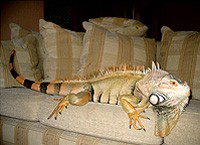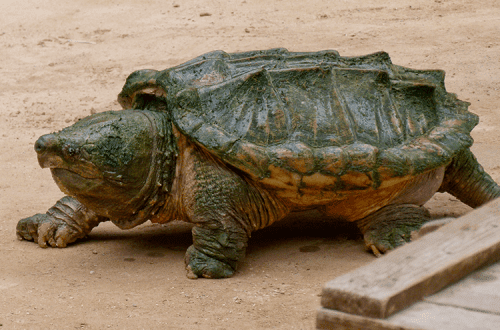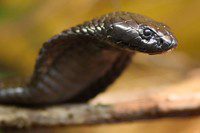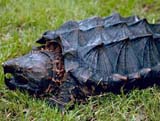
vulture turtle
The vulture turtle (Macroclemys temmincki) is similar to the caiman turtle. It can be distinguished by its laterally directed eyes, a longer, hook-shaped beak, and a series of supramarginal scutes. When handled, she usually does not bite, but only opens her mouth wide and spews a stream of liquid from the anal blisters. However, you should not test the calmness of the vulture turtle, because in irritation it can bite hard. The vulture turtle is used along with the caiman turtle to make turtle soup. However, in terms of meat quality, this species is somewhat inferior to the previous one. Lives for decades when kept in captivity; one specimen survived in captivity to 59 years.
Food
The main diet of the vulture turtle is fish. Lying motionless at the bottom, half buried in the silt, she opens her mouth, sticks out a worm-shaped bright pink thin tip of her tongue, which is a bait for fish – swimming up, they try to grab it, but at the same moment they fall into her iron jaws.
She can also eat water birds, worms, snails, crayfish, snakes, small mammals and turtles, plants.
Reproduction
Mating takes place in early spring. The laying itself takes place in May-June. In a hole in the shape of a jug up to half a meter deep, which she herself digs in the sand with her hind legs, the female lays from 20 to 40 eggs.
Content
 In captivity, it can live for a very long time – 40-50 years.
In captivity, it can live for a very long time – 40-50 years.
For maintenance, a large aquaterrarium is required. There should be more water in it than land. Glass and walls need to be strengthened.
You need to be prepared for frequent water changes and prepare a powerful filter. The water level itself should not be very high, since the vulture turtle is not a very good swimmer.
Additionally
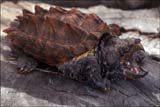 When irritated, the vulture turtle can bite very hard. When picked up, she usually does not do this, but opens her mouth wide, which looks very intimidating and spews streams of smelly liquid from the anal bladders.
When irritated, the vulture turtle can bite very hard. When picked up, she usually does not do this, but opens her mouth wide, which looks very intimidating and spews streams of smelly liquid from the anal bladders.
Just like the caiman turtle, the vulture turtle is used in cooking (turtle soup).
The species is listed in the International Red Book.
In the state of California, it is illegal to keep this species of turtles as dangerous to humans.
Sources of
http://ru.wikipedia.org
http://live.1001chudo.ru
http://www.floranimal.ru
http://www.cherepahi.ru
http://www.apus.ru
http://otvetin.ru
Description
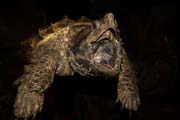 This turtle is similar to the caiman turtle. A distinctive feature are her eyes – they are directed sideways. Around the eyes are the so-called “eyelashes” – star-shaped outgrowths. She also has a hooked long beak located on the upper jaw and, lying between the marginal and lateral shields, a number of supramarginal ones.
This turtle is similar to the caiman turtle. A distinctive feature are her eyes – they are directed sideways. Around the eyes are the so-called “eyelashes” – star-shaped outgrowths. She also has a hooked long beak located on the upper jaw and, lying between the marginal and lateral shields, a number of supramarginal ones.
On the back, the horny shields of the carpax form three sawtooth longitudinal ridges. The carapace itself is most often from dark brown to mahogany color, although the real color can not always be determined – most often the vulture turtle is covered with a dense layer of algae. The edge of the carapace is strongly serrated at the back. Plastron yellowish, very small. It practically does not protect the soft parts of the body from below.
In length, the vulture turtle reaches one and a half meters, the weight approaches 60 kg.
Inhabitation
This turtle lives in the southeastern United States, mainly in the Mississippi River basin and in the north near Illinois, in canals, rivers and ponds.
It spends most of its life in water, crawling out to land only for masonry.
Other names
Macroclemys temminckii, alligator biting.



